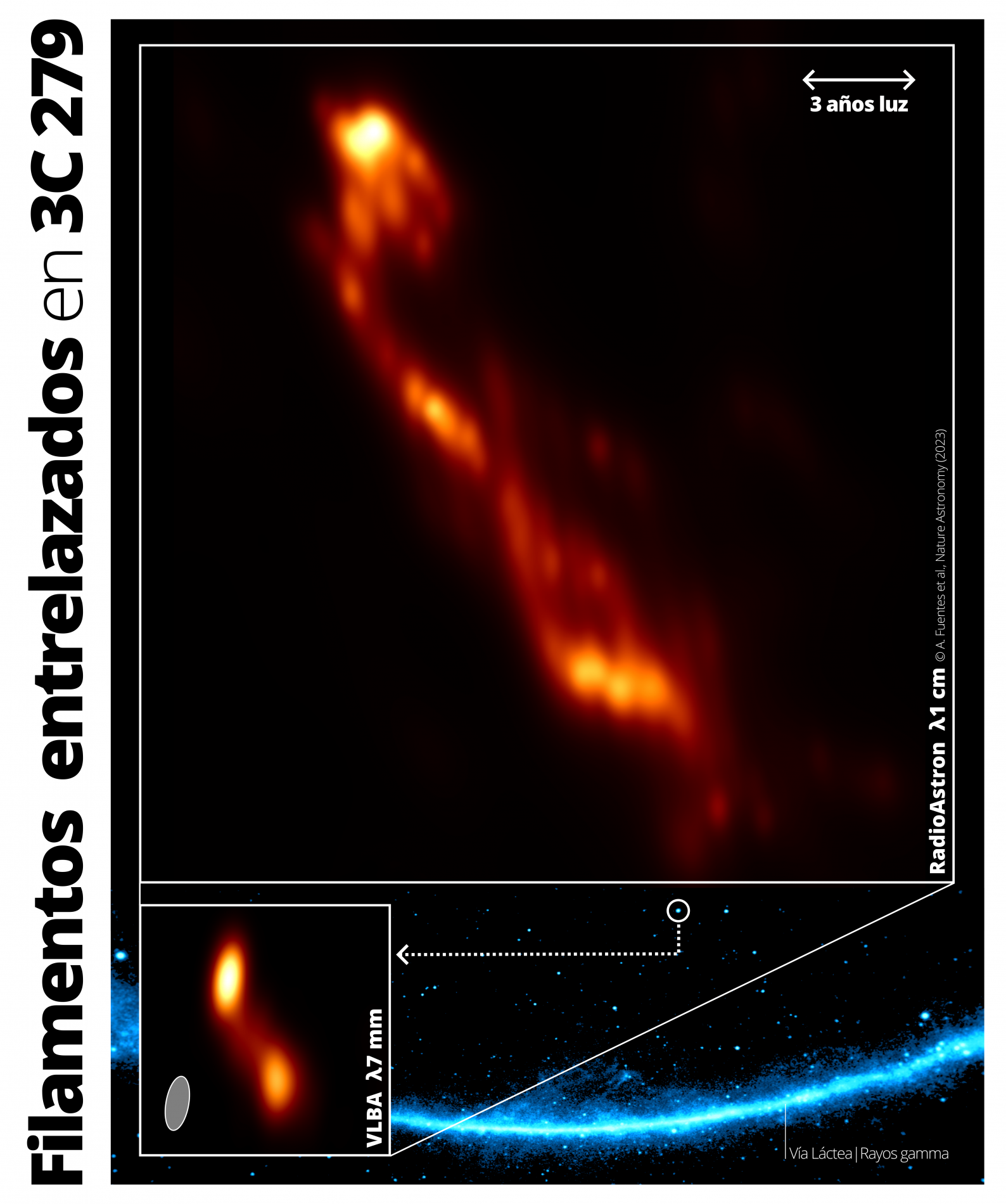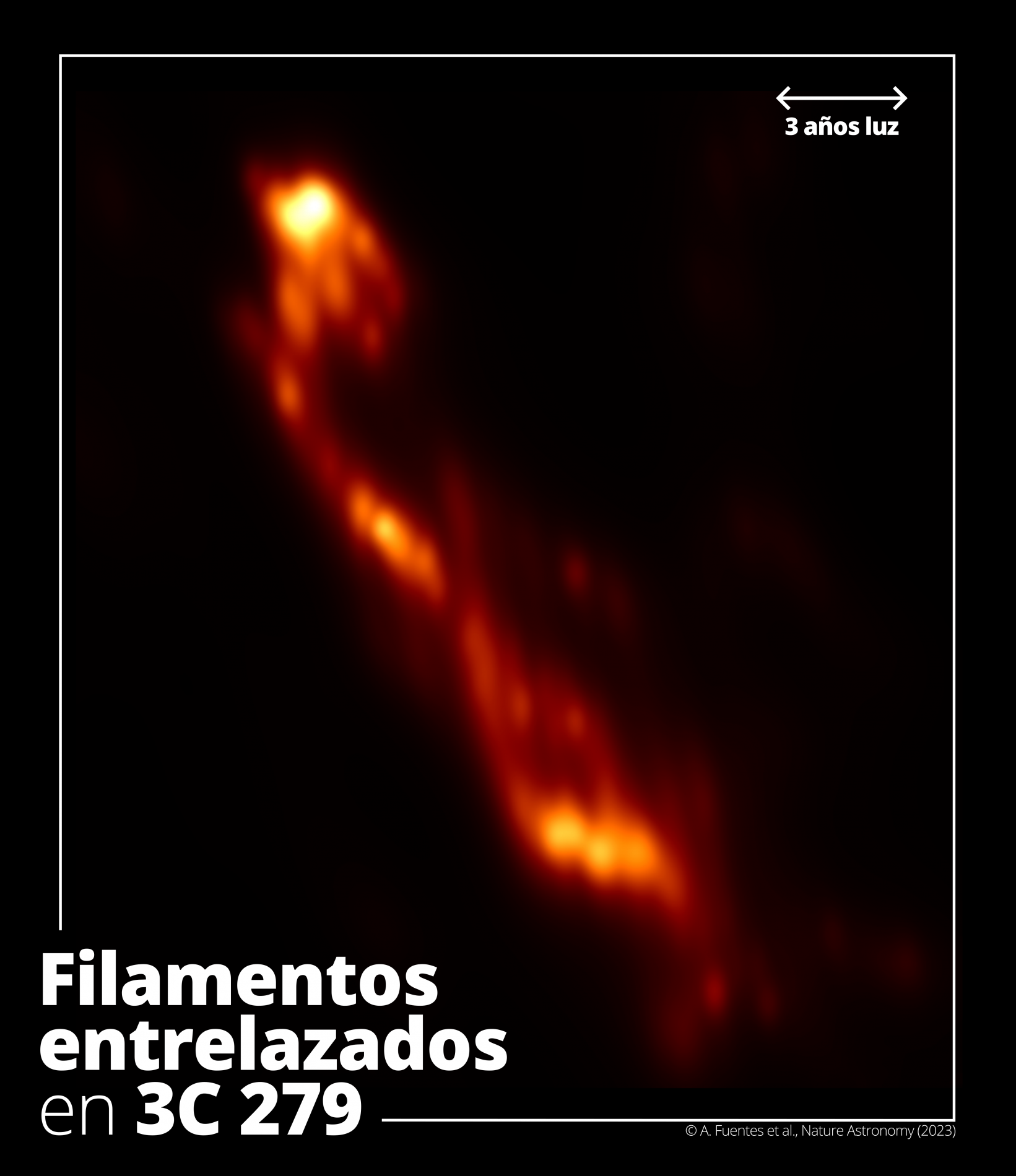Space interferometry observations reveal helical filaments inside a supermassive black hole's jet stream
The Instituto de Astrofísica de Andalucía (IAA-CSIC) leads the observation with the highest resolution and sensitivity of the jet of material emerging from the nucleus of galaxy 3C 279 at almost the speed of light. The image shows large helical filaments at their base, the existence of which requires an alternative model to the one used for the last four decades to explain the variability of these jets.
Blazars are the most powerful sources of continuum radiation in the universe. Like all active galaxies, they show a structure formed by a central supermassive black hole surrounded by a disc of matter that feeds it, but they are among the 10% of active galaxies that show a jet of matter emerging from both poles at very high speed, and among the even smaller percentage of cases in which their orientation allows us to see the jet almost head-on. Now, a group of researchers led by the Instituto de Astrofísica de Andalucía (IAA-CSIC) has observed the jet of the galaxy 3C 279 with unprecedented resolution and found helical filaments with a double helix structure that requires an update of the theoretical models used so far.

High-resolution image of the relativistic jet in blazar 3C 279 obtained with RadioAstron. The image reveals a complex structure within the jet with several filaments on parsec scales forming a helix-like structure. The Very Long Baseline Array image and the location of the source on the sky are shown for comparison (note that the scales are very different). Credit: NASA/DOE/Fermi LAT Collaboration; VLBA/Jorstad et al.; RadioAstron/Fuentes et al.
"Thanks to RadioAstron, an orbiting radio telescope capable of reaching distances close to the Moon, and a network of twenty-three radio telescopes around the Earth, we have obtained the highest resolution image of the interior of a blazar to date, which has allowed us to observe for the first time the internal structure of the jet," says Antonio Fuentes, a researcher at the Instituto de Astrofísica de Andalucía (IAA-CSIC) who leads the work.
The result, published in Nature Astronomy, reveals that the jet of 3C 279 shows a complex structure composed of at least two helical filaments that extend from near the core to more than 570 light-years away. This is a structure never seen before, and it extends a previous result: in 2020, the Event Horizon Telescope (EHT), which obtained the first image of a black hole in 2019, revealed unexpected structures in the core of 3C 279, but the sensitivity provided by the EHT was insufficient to observe the filaments.
"The properties of the helical filaments allow us to conclude that they are caused by instabilities in the plasma that make up the jets. Adding up all the ingredients, we found that the model used for four decades to explain the radio variability associated with the jets does not work in this case, so we propose an alternative model to explain it, which takes into account the newly observed structures," says Antonio Fuentes (IAA-CSIC).
In addition, the study points to the presence of a helical magnetic field that confines the jet. It would therefore be the magnetic field, which in 3C 279 rotates clockwise around the jet, which channels the material that travels along it at a speed of 0.997 times the speed of light.
"This result, together with other recent results, suggests that blazar jets have a complex and rich internal structure, beyond the cone-shaped morphologies observed in lower-resolution studies. Our results also open the door to the reinterpretation and reanalysis of many other such sources, and highlight the importance of new global networks of radio telescopes with higher angular resolution and sensitivity, such as the Next Generation EHT in the next decade and, in the longer term, space missions operating at millimetre wavelengths," concludes José Luis Gómez, researcher at the IAA-CSIC and co-author of the paper.

High-resolution image of the relativistic jet in blazar 3C 279 obtained with RadioAstron. The image reveals a complex structure within the jet with several filaments on parsec scales forming a helix-like structure. Credit: RadioAstron/Sources et al.
A. Fuentes, J. L. Gómez et al. "Filamentary structures as the origin of blazar jet radio variability". Nature Astronomy, DOI: 10.1038/s41550-023-02105-7
Instituto de Astrofísica de Andalucía (IAA-CSIC)
Unidad de Divulgación y Comunicación
Emilio García - garcia@iaa.es - 649407445

